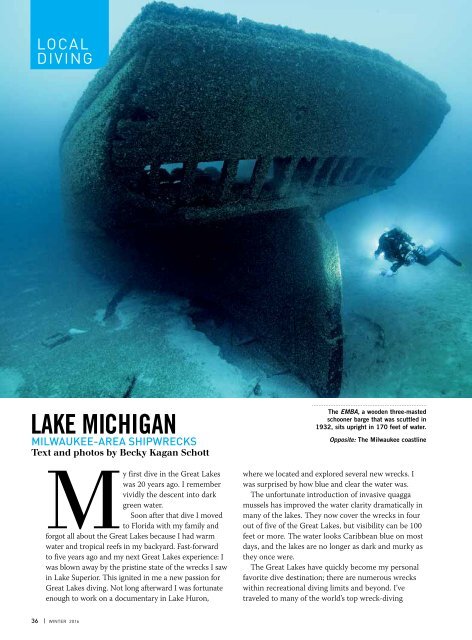AD 2016 Q1
You also want an ePaper? Increase the reach of your titles
YUMPU automatically turns print PDFs into web optimized ePapers that Google loves.
LOCAL<br />
DIVING<br />
LAKE MICHIGAN<br />
MILWAUKEE-AREA SHIPWRECKS<br />
Text and photos by Becky Kagan Schott<br />
My first dive in the Great Lakes<br />
was 20 years ago. I remember<br />
vividly the descent into dark<br />
green water.<br />
Soon after that dive I moved<br />
to Florida with my family and<br />
forgot all about the Great Lakes because I had warm<br />
water and tropical reefs in my backyard. Fast-forward<br />
to five years ago and my next Great Lakes experience: I<br />
was blown away by the pristine state of the wrecks I saw<br />
in Lake Superior. This ignited in me a new passion for<br />
Great Lakes diving. Not long afterward I was fortunate<br />
enough to work on a documentary in Lake Huron,<br />
The EMBA, a wooden three-masted<br />
schooner barge that was scuttled in<br />
1932, sits upright in 170 feet of water.<br />
Opposite: The Milwaukee coastline<br />
where we located and explored several new wrecks. I<br />
was surprised by how blue and clear the water was.<br />
The unfortunate introduction of invasive quagga<br />
mussels has improved the water clarity dramatically in<br />
many of the lakes. They now cover the wrecks in four<br />
out of five of the Great Lakes, but visibility can be 100<br />
feet or more. The water looks Caribbean blue on most<br />
days, and the lakes are no longer as dark and murky as<br />
they once were.<br />
The Great Lakes have quickly become my personal<br />
favorite dive destination; there are numerous wrecks<br />
within recreational diving limits and beyond. I’ve<br />
traveled to many of the world’s top wreck-diving<br />
36 | WINTER <strong>2016</strong>









